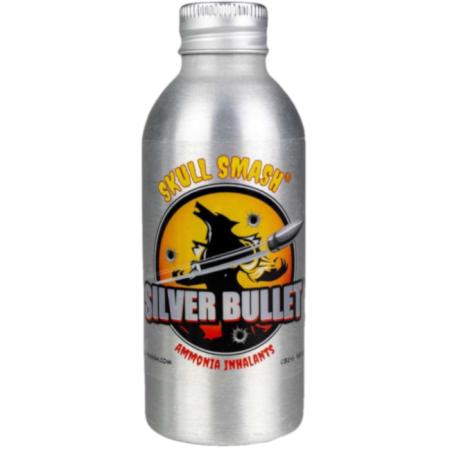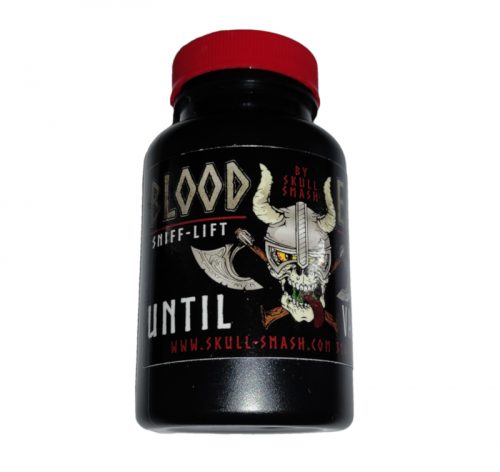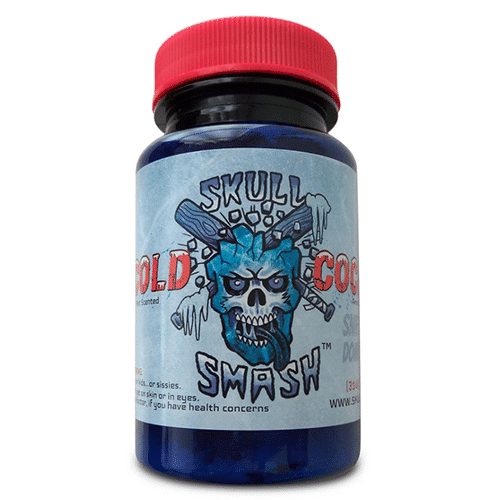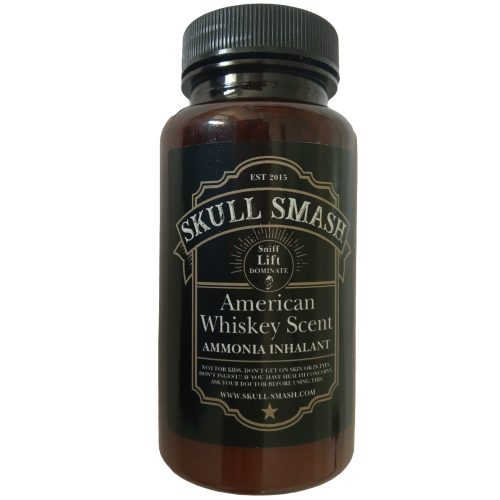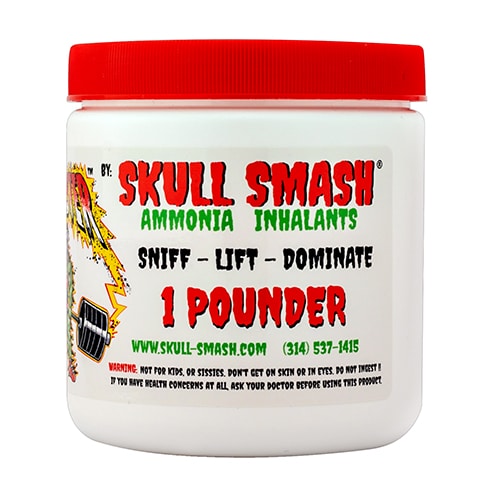Silver Bullet by Skull Smash! LEMON SCENTED EDITION in metal casing designed to last long and tolerate abuse!
Silver Bullet Skull Smash Ammonia Inhalant
$41.00
In stock
In stock
Description
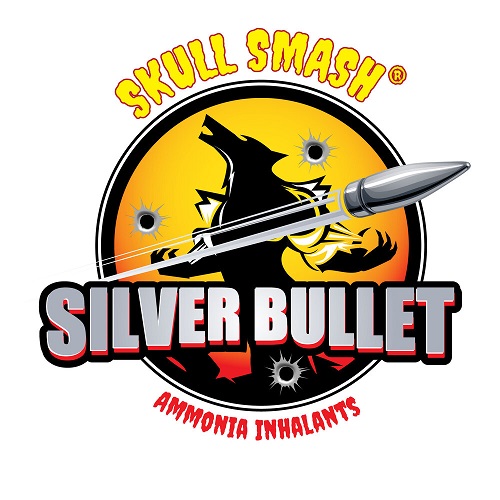
Introducing our all new… revolutionary, first on the market… LEMON SCENTED SILVER BULLET EDITION.
Skull Smash Silver Bullet is our first product in a metal container. This large size bottle will not only last a very long time, it will tolerate some of the abuse that ammonia bottles are known to perish from when lifters get a little too excited in the gym.
The metal casing doesn’t allow the moisture inside the bottle to permeate out as quickly, making our long lasting ammonia last even longer!
The wide body holds an ample amount of our world famous formula, and funnels the power up through a smaller opening for a highly concentrated, sharp, excellent hit of this powerful, LEMON SCENTED edition of Skull Smash.
Tired of lackluster ammonia inhalants? Our competitors import and re-label low grade Chinese Ammonium Carbonate from Alibaba.
Our approach is to source quality American made products and we’re proud to introduce Skull Smash.
Formulated in the United States by U.S. military veteran and competitive powerlifter, gym owner and coach of 20 years. Expect the hardcore in these inhalants.
Each bottle is formulated with high potency unique proprietary blend and stored under cool conditions in sealed packaging. No leakage and maximum efficiency.
Avoid heat damaged re-sealed cotton-stuffed Chinese imports that are ‘dead on arrival’, try Skull Smash today
More information on the official Skull Smash Australia website – http://www.skullsmash.com.au
- Legal for use in IPF and all Powerlifting federations
- WADA/ASADA legal
- Keep out of reach of children
- Avoid contact with eyes and skin as irritation may occur
- Not for oral intake/consumption
- Ingredients: 100% Ammonium Carbonate
- Directions for use: Remove seal and lightly shake the bottle. Place the bottle at the distance of half an arm’s length and gradually move the bottle towards the nose to gauge desired tolerance of potency. Do not directly place the bottle on your nostrils or the nostrils of other persons.
Warning/MSDS
Skull Smash Ammonia products are made to be inhaled by strength enthusiasts in conjunction with their training and competitions. Skull Smash products are NOT intended for medical use, or to treat any illness or condition. You use these completely at your own risk, and by your own decision and judgement that these are suitable for your personal use. As with most compounds and aids of this sort, there are potential risks and hazards. You should seek the advice of a medical professional before using these, or any Skull Smash products, especially if you have concerns.
Ammonia gas is toxic in large concentrations, and for long periods of time can be very hazardous. Since smelling salts produce only a small amount of ammonia gas, and with normal, responsible use, and if the individual isn’t exposed for long periods of time, serious complications or hazards are rare, and we are unaware of anyone experiencing any ill health affects from normal use. However, a high concentration of inhaled ammonia might burn the nasal passages or lungs. Please use responsibly, and seek medical advice if you have any concerns.
- Legal for use in IPF and all Powerlifting federations
- WADA/ASADA legal
- Keep out of reach of children
- Avoid contact with eyes and skin as irritation may occur
- Not for oral intake/consumption
- Ingredients: 100% Ammonium Carbonate
- Directions for use: Remove seal and lightly shake the bottle. Place the bottle at the distance of half an arm’s length and gradually move the bottle towards the nose to gauge desired tolerance of potency. Do not directly place the bottle on your nostrils or the nostrils of other persons.
Material Safety Data Sheet Ammonium chloride MSDS
Section 1: Chemical Product and Company Identification
Product Name: Ammonium chloride Catalog Codes: SLA3415, SLA1069, SLA2575, SLA4078,
SLA1732, SLS3118 CAS#: 12125-02-9 RTECS: BP4550000 TSCA: TSCA 8(b) inventory: Ammonium chloride CI#: Not applicable.
Synonym: Ammonium Chloratum; Ammonium Chloridum; Ammonium Muriate; Sal Ammonia; Salmiac
Chemical Name: Ammonium Chloride Chemical Formula: NH4Cl
Section 2: Composition and Information on Ingredients
Composition:
Toxicological Data on Ingredients: Ammonium chloride: ORAL (LD50): Acute: 1650 mg/kg [Rat.]. 1300 mg/kg [Mouse].
Name
CAS #
% by Weight
Ammonium chloride
12125-02-9
100
Section 3: Hazards Identification
Potential Acute Health Effects:
Hazardous in case of eye contact (irritant). Slightly hazardous in case of skin contact (irritant, sensitizer), of ingestion, of inhalation.
Potential Chronic Health Effects:
CARCINOGENIC EFFECTS: Not available. MUTAGENIC EFFECTS: Not available. TERATOGENIC EFFECTS: Not available. DEVELOPMENTAL TOXICITY: Not available. Repeated or prolonged exposure is not known to aggravate medical condition.
Section 4: First Aid Measures
Eye Contact:
p. 1
Check for and remove any contact lenses. In case of contact, immediately flush eyes with plenty of water for at least 15 minutes. Cold water may be used. Get medical attention.
Skin Contact:
In case of contact, immediately flush skin with plenty of water. Cover the irritated skin with an emollient. Remove contaminated clothing and shoes. Cold water may be used.Wash clothing before reuse. Thoroughly clean shoes before reuse. Get medical attention.
Serious Skin Contact:
Wash with a disinfectant soap and cover the contaminated skin with an anti-bacterial cream. Seek immediate medical attention.
Inhalation:
If inhaled, remove to fresh air. If not breathing, give artificial respiration. If breathing is difficult, give oxygen. Get medical attention.
Serious Inhalation: Not available.
Ingestion:
Do NOT induce vomiting unless directed to do so by medical personnel. Never give anything by mouth to an unconscious person. If large quantities of this material are swallowed, call a physician immediately. Loosen tight clothing such as a collar, tie, belt or waistband.
Serious Ingestion: Not available.
Section 5: Fire and Explosion Data
Flammability of the Product: Non-flammable. Auto-Ignition Temperature: Not applicable. Flash Points: Not applicable. Flammable Limits: Not applicable.
Products of Combustion: Not available. Fire Hazards in Presence of Various Substances: Not applicable.
Explosion Hazards in Presence of Various Substances:
Risks of explosion of the product in presence of mechanical impact: Not available. Risks of explosion of the product in presence of static discharge: Not available.
Fire Fighting Media and Instructions: Not applicable.
Special Remarks on Fire Hazards:
Reaction between Ammonium Chloride and Bromine pentafluoride at ambient or slightly elevated temperature is violent, and ignition often occurs.
Special Remarks on Explosion Hazards: Explosive reaction between bromine trifluoride and ammonium halides.
Section 6: Accidental Release Measures
Small Spill:
Use appropriate tools to put the spilled solid in a convenient waste disposal container. Finish cleaning by spreading water on the contaminated surface and dispose of according to local and regional authority requirements.
Large Spill:
Use a shovel to put the material into a convenient waste disposal container. Be careful that the product is not present at a concentration level above TLV. Check TLV on the MSDS and with local authorities.
Section 7: Handling and Storage
p. 2
Precautions:
Do not ingest. Do not breathe dust. Wear suitable protective clothing. In case of insufficient ventilation, wear suitable respiratory equipment. If ingested, seek medical advice immediately and show the container or the label. Avoid contact with skin and eyes. Keep away from incompatibles such as oxidizing agents, acids, alkalis.
Storage: Keep container tightly closed. Keep container in a cool, well-ventilated area.
Physical state and appearance: Solid. (Solid crystalline powder.) Odor: Odorless. (Slight.) Taste: Cooling, Saline. Molecular Weight: 53.49 g/mole
Color: White. pH (1% soln/water): 5.5 [Acidic.] Boiling Point: 520°C (968°F) Melting Point: Decomposition temperature: 338°C (640.4°F) Critical Temperature: Not available. Specific Gravity: 1.53 (Water = 1) Vapor Pressure: Not applicable. Vapor Density: Not available. Volatility: Not available. Odor Threshold: Not available. Water/Oil Dist. Coeff.: Not available. Ionicity (in Water): Not available. Dispersion Properties: See solubility in water, methanol. Solubility:
Section 8: Exposure Controls/Personal Protection
Engineering Controls:
Use process enclosures, local exhaust ventilation, or other engineering controls to keep airborne levels below recommended exposure limits. If user operations generate dust, fume or mist, use ventilation to keep exposure to airborne contaminants below the exposure limit.
Personal Protection:
Splash goggles. Lab coat. Dust respirator. Be sure to use an approved/certified respirator or equivalent. Gloves.
Personal Protection in Case of a Large Spill:
Splash goggles. Full suit. Dust respirator. Boots. Gloves. A self contained breathing apparatus should be used to avoid inhalation of the product. Suggested protective clothing might not be sufficient; consult a specialist BEFORE handling this product.
Exposure Limits:
TWA: 10 STEL: 20 (mg/m3) from ACGIH (TLV) [United States] Inhalation TWA: 10 STEL: 20 (mg/m3) [United Kingdom (UK)] Inhalation TWA: 10 STEL: 20 (mg/m3) from NIOSH [United States] Inhalation TWA: 10 STEL: 20 (mg/m3) from OSHA (PEL) [United States]Consult local authorities for acceptable exposure limits.
Section 9: Physical and Chemical Properties
p. 3
Soluble in cold water, hot water, methanol. Insoluble in diethyl ether, acetone. Almost insoluble in ethyl acetate. Very slightly soluble in Ethanol; Solubility in Ethanol: 0.6 g/100 ml water at 19 deg. C. Solubility in Water: 29.7 g/100ml water at O deg. C 75.8 g/100 ml water at 100 deg. C 37.8 lbs./100 lbs. water at 70 deg. F 28.3% (w/w) in water at 25 deg. C Soluble in liquid ammonia.
Ecotoxicity: Not available. BOD5 and COD: Not available.
Section 10: Stability and Reactivity Data
Stability: The product is stable. Instability Temperature: Not available. Conditions of Instability: Incompatible materials, moisture. Incompatibility with various substances: Reactive with oxidizing agents, acids, alkalis.
Corrosivity:
Extremely corrosive in presence of copper. Corrosive in presence of steel, of stainless steel(304). Slightly corrosive in presence of aluminum, of stainless steel(316).
Special Remarks on Reactivity:
Incompatible with lead and silver salts. It can react violently with ammonium nitrate and potassium chlorate. Also incompatible with bromine trifluoride, ammonium halides, bromine pentafluoride, alkalis and their carbonates. At fire temperature, ammonium chloride may dissociate into ammonia and hydrogen chloride. Hygroscopic; keep container tightly closed.
Special Remarks on Corrosivity: Severe corrosive effect on brass and bronze. Polymerization: Will not occur.
Section 11: Toxicological Information
Routes of Entry: Inhalation. Ingestion.
Toxicity to Animals: Acute oral toxicity (LD50): 1300 mg/kg [Mouse].
Chronic Effects on Humans: Not available.
Other Toxic Effects on Humans: Slightly hazardous in case of skin contact (irritant, sensitizer), of ingestion, of inhalation.
Special Remarks on Toxicity to Animals:
Lowest Published Lethal Dose: LDL [Human Infant] – Route: Oral; Dose: 2000 mg/kg
Special Remarks on Chronic Effects on Humans: May affect genetic material (mutagenic) Animal: passes through the placental barrier.
Special Remarks on other Toxic Effects on Humans:
Acute Potential Health Effects: Skin: It can cause skin irritation which is usually mild. Eyes: Causes moderate eye irritation. It may cause Salt Cataract, increased ocular pressure, and degeneration of the retina Inhalation: It can cause respiratory tract and mucous membrane irritation which is usually mild. Ingestion: May be harmful if swallowed. May cause digestive tract irritation with nausea and vomiting, and thirst. May affect behavior/central nervous system (headache, somnolence, confusion, drowsiness, tremor, convulsions, coma), eyes (Mydriasis), cardiovascular system (bradycardia), respiration (respiratory stimulation, apnea, hyperventilation, pulmonary edema). May cause serious metabolic acidosis with h y p o k a l e m i a . T r a n s i e n t hyperglycemia and glycosuria may also occur. Chronic Potential Health Effects: Skin: Prologned or repeated contact may cause dermatitis, an allergic reaction. Inhalation: Prolonged or repeated inhalation may affect the kidneys. Ingestion: Prolonged or repeated ingestion may affect metabolism (anorexia, metabolic acidosis) and urinary system (enlargement of kidneys). Inhalation: Prolonged or repeated inhalation may cause bronchospasm (asthma)
Section 12: Ecological Information
p. 4
Products of Biodegradation:
Possibly hazardous short term degradation products are not likely. However, long term degradation products may arise. Toxicity of the Products of Biodegradation: The products of degradation are less toxic than the product itself. Special Remarks on the Products of Biodegradation: Not available.
Section 13: Disposal Considerations
Waste Disposal:
Waste must be disposed of in accordance with federal, state and local environmental control regulations.
Section 14: Transport Information
DOT Classification: Not a DOT controlled material (United States). Identification: : Not available. UNNA: 9085 PG: III Special Provisions for Transport: Not applicable.
Section 15: Other Regulatory Information
Federal and State Regulations:
Illinois toxic substances disclosure to employee act: Ammonium chloride Illinois chemical safety act: Ammonium chloride New York release reporting list: Ammonium chloride Rhode Island RTK hazardous substances: Ammonium chloride Pennsylvania RTK: Ammonium chloride Minnesota: Ammonium chloride Massachusetts RTK: Ammonium chloride Massachusetts spill list: Ammonium chloride New Jersey: Ammonium chloride New Jersey spill list: Ammonium chloride Louisiana spill reporting: Ammonium chloride California Director’s List of Hazardous Substances: Ammonium chloride TSCA 8(b) inventory: Ammonium chloride CERCLA: Hazardous substances.: Ammonium chloride: 5000 lbs. (2268 kg)
Other Regulations: EINECS: This product is on the European Inventory of Existing Commercial Chemical Substances. Other Classifications: WHMIS (Canada): Not controlled under WHMIS (Canada). DSCL (EEC):
HMIS (U.S.A.): Health Hazard: 2 Fire Hazard: 0 Reactivity: 0 Personal Protection: E
National Fire Protection Association (U.S.A.): Health: 2
Flammability: 0 Reactivity: 0 Specific hazard:
Protective Equipment:
Gloves. Lab coat. Dust respirator. Be sure to use an approved/certified respirator or equivalent. Splash goggles.
Section 16: Other Information
p. 5
References:
-Material safety data sheet emitted by: la Commission de la Santé et de la Sécurité du Travail du Québec. -The Sigma- Aldrich Library of Chemical Safety Data, Edition II. -Hawley, G.G.. The Condensed Chemical Dictionary, 11e ed., New York N.Y., Van Nostrand Reinold, 1987. -Manufacturer’s Material Safety Data Sheet.
Other Special Considerations: Not available. Created: 10/11/2005 11:17 AM Last Updated: 05/21/2013 12:00 PM
The information above is believed to be accurate and represents the best information currently available to us. However, we make no warranty of merchantability or any other warranty, express or implied, with respect to such information, and we assume no liability resulting from its use. Users should make their own investigations to determine the suitability of the information for their particular purposes. In no event shall Skull Smash or its agents of holders be liable for any claims, losses, or damages of any third party or for lost profits or any special, indirect, incidental, consequential or exemplary damages, howsoever arising, even if Skull Smash, its agents or holders have been advised of the possibility of such damages.

